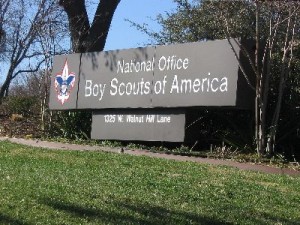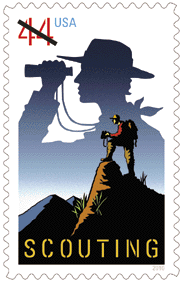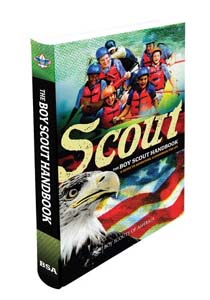The Boy Scouts of America in three parts:
Part I – Being a Boy Scout | Part II – Masonic Origins? | Part III – Organization

Having looked at the past 100 years of the Boy Scouts, it is important to spend some time on their organization so as to put into perspective how it operates and perhaps take a lesson for how a member centric organization functions with a national leadership while still retaining its local focus. The value of having a national organization is easy to see when you look beyond the titles and examine the work being performed in service to the organization. Rather than platitudes and titles, an engine of progress and motion is working behind the scenes to grow, nurture, and build the overall brand, something that Freemasonry does not have in a way comparable to that of the BSA.
An initial aspect of interest with the Boy Scouts as a body is that the national organization structure removes the diversity of individual states from practicing Scouting in their own manner and sets a national standard by which the entire body adheres to. Further it delegates down from the top to the increasingly more local organizations the management and practice down to the Troop level through committees and charter councils. At the lowest rungs the troop becomes, like the lodge, the local corporate unit, still broken into patrols which function within the troop. This seems to have allowed for the troops to retain a diversity of its local community from which the members reside.
An interesting aspect of juxtapose is to look at the Scout Troop to a system, more familiar to readers, of the Masonic lodge. Troops are made up of members from the local community, staffed by their parents and guardians, and chartered by an organization (church, civic group, business, etc) to operate. The group meets in weekly meetings for the purpose of training, planning, rank progression, with a variety of activities taking place at any given time. The meeting has leadership that directs it (similar to a Worshipful Master) with junior officers (like the Wardens) who assist where and when necessary. The meetings have a distinct purpose however, and like a corporate business meeting, it breaks out into teams to accomplish its various tasks, something unlike a Masonic Lodge meeting.

To appreciate the local operation, we should look at how the Scouts operate from a national level that makes its way to the troops.
First Masonry, as most readers will know, is based on a lodge system with each local lodge reporting loosely to a regional management (or District Inspector) but directly through its charter reports to a state level governance, called the Grand Lodge. In North American Masonry, the reporting structure stops there as directives, edicts, publications, and announcements come from it. The Grand Lodge also functions as the state point of contact for marketing, brand protection, and broader national communication. In a direct line, the individual Mason reports to a lodge, and the lodge to a Grand Lodge. In this line of succession there is some blurred lines of responsibility as to public interaction and marketing go (if any exist at all), and practice is set by the Grand Lodge based loosely on its custom which varies in nuance from state to state in dress, recognition between bodies, landmarks of the institution, and custom. At a high level lodges have similar practice, but custom and dress has a great degree of variance from local lodges between states, because of a lack of standardization. Observational, this has created silo’s of Freemasonry rather than a unified national body as with the Boy Scouts. Perhaps in its founding this was an organizational hazard and part of its planned incorporation to cultivate a unified message and purpose.
Structurally, the Boy Scout’s are localized at every level so as to meet the needs of its constituency. Diagrammatically, the troop reports to a unit committee, which reports to the Chartered Organization which then reports to a District, and then a Local Council. The Local council in return reports up to an Area Committee, which then report to a Regional who in turn reports to a National Council.
By reporting level this looks like:
National Council, BSA
This level is the overall leadership in the Executive Board and sets the general direction of the of the work of the Scouts. This Board is entirely volunteer except for the National Commissioner, International Commissioner, and the Chief Scout Executive. The Council develops programs; sets and maintains quality standards in training, leadership selection, uniforming, registration records, literature development, and advancement requirements. It does not directly administer to the troops, packs, venturing crews, etc, rather it delegates downward.
Regional Council (Committee and Board)
The country is broken into Regions for better management and governed by a Regional Committee and Council. The Council exercises the authority and responsibility of the Regional Committee whenever the Regional Committee is not in session but both function to implement national BSA policy and programs. Additionally it plans events and activities for its specific region and to train members of the various standing committees. All members at this level are also volunteers.
The Regional Board conducts the affairs of Scouting in the region on a day to day basis in conformity with regional committee and board policy
Area Council
Regions are further broken into areas where the Area council functions similarly o the Regional in setting, managing, and implementing local activities.
Local Council
Local councils are usually not-for-profit private corporations registered within the State in which they are headquartered, they administer any program they wish in the BSA portfolio through an annually issued charter to administer the BSA programs in their area. To hold the charter the Council adheres to certain program, financial and accounting standards. Local councils are privately funded and are not financially linked to the National Council or local units. Funding comes from donations, corporate sponsors, and special events. The local council is led by volunteers, with administration performed by a staff of professional Scouters. The Council President is the top volunteer; the Scout Executive is the top professional. In many ways this appears as essentially a franchise from the national body.
Local Councils promote the Scouting programs, register units and personnel, provide facilities and leadership for year-round outdoor programs and summer camps, and insure the general principals of scouting are adhered to. Additionally they insure the integrity of the merit badge system, ensures badges-and insignia are protected, and provide training to the Local Units and community groups using the Scouting program. Most importantly the Local Council sets the standards in Scout policies (locally).
Local Councils report to Regional Councils on finances, scouting membership, numbers of scouts attending camps and on their review of charter renewal applications for the Troops and Packs.
District
The District is an optional add-on to mobilize resources in the growth and success of Scouting units in the area. Traditionally they are composed of volunteers, and provide training, and programs for Scouts.
Chartered Organization
This is the sponsoring body that owns and runs a particular Scout Troop granted as a franchise of sorts) to operate a Boy Scout unit. Typically the chartered organization has goals similar to the Scouting organization such as a school, church, civic organization, business, etc. The chartering organization provides a meeting place for the Scouts, selects a Scoutmaster, approves unit leadership and provides a representative to liaise with the Troop.
Unit committee
The Unit committee is three composed of three or more qualified adults selected by the chartered organization who’s responsibility is to deliver quality unit programs, manage unit administration, and utilizes programs to accomplish the Troops goals and development.
Individual Unit – Troop
The Unit is composed of the Scouts themselves, which are broken into patrols which have their own structure of operation including Scribes, Quartermasters, Librarians, Chaplin, Guides, Historians, Assistant Patrol Leaders, and instructors, as well as many others. This is the essential functioning component of the Scouts and the most fundamental expression of the Boy Scouts purpose.
At the Troop level, then, is the foundation of the Scouts life, like the Lodge for the Mason. The Troop is a fluid body of new and returning members which functions to facilitate the Scout experience. Meetings consist of training on the basis of First aid to the types of lashings to affix two or more poles together. A function of the Scout meeting is the individual progress of the Scouts. Unlike Masonry, the Boy Scouts have a variety of testable points by which the candidate progresses. These points, spread between merit badges, knot tying, projects, teaching, and memorization. These processes serve to bring the Scout into a tight relationship with the corporate body, progressing through a series of ranks demarcated with each subsequent achievement. It’s in these progressions that a highly valuable lesson is taught to the member , lessons retained for the rest of their life. For example the Scout learns the fundamentals of first aid, how to tie a knot to secure materials in place, conservation, leadership, and even how to plan a complex and multi thousand dollar project. All of this takes place weekly at the recurring troop meeting.
Adapted from the U.S. Scout Service Project.
As you can see, the organization is deep in that there is a tremendous infrastructure to protect its purpose and product. One of the most notable elements in recent history is the close and careful cultivation of the Boy Scout Brand which is one of its strongest corporate properties and essentially the product itself which is licensed or franchised to the Chartering body.
This level of brand development/protection is outside the capacity of Masonry at present and likely the cause of its slip in public awareness (especially when contrasted in the work of the Shrine which has a highly cultivated presence and brand). The model of the Scouts organization is something that Masonry can take a lesson from in several ways. First to disassociate the idea of the Lodge as the focal point for the group activity which allows the attention instead to be focused on activities, projects, and community engagement rather than utility bills and infrastructure management. The importance of the body of work performed out shines the landed importance on the place in which the work takes place. This is not to suggest a franchising, but the experimentation of an un-landed lodge (like a traveling lodge) that can focus on its community involvement by literally being in the community.

Also, having a National Organization, unlike the Masonic Grand Lodge system, allows for a specific set of standardized processes that can be made universal so that each operating lodge has a basis of operation integrity especially when coupled with a leadership structure which allows the adoption of locally flavored practice and preferences with permutations built into the foundational rules local users. In essence, the infrastructure allows for the BSA Troops to operate without worry as to what they are in operation of, they have a National Standard of material and an activity chain of National command supporting and growing the organization. We can see this in the basic principal of the Boy Scout Handbook where essentially the codex of Scouting resides.
Responsibility still ultimately falls on the local body, but with an arsenal of tools, training, a strong stable brand, and a national level of marketing the work of the local can more specifically focus on the work of building Boy Scouts.
In conceiving the organization, its easy to say that it is a complex model of operation. Boy Scout Troops are thriving across the country (and world) and continue to offer programs for young people. A Wikipedia article on recent Boy Scout Controversies places numbers just over 2.7 million members (in all Scouting groups) as of 2009, with a similar downward trend that Freemasonry is experiencing (roughly a 22% average per decade loss).
Without a doubt there are many lessons to take away from the Boy Scouts, from their history, their operation, and their organization. Unlike most century old institutions, looking at what has taken shape in the last 100 years to coalesce into what it is today, an outsider can be encouraged to imagine what the Boy Scouts of America will become in its next century. Strong leadership from early visionaries and a strong organizational foundation has allowed for the progression of a clear vision of purpose to promote “patriotism, courage, self-reliance, and kindred values”, all of which the Boy Scouts have cultivated. They are truly an American institution and an asset to the spirit of young people everywhere. Being Prepared is every bit the noble endeavor it seems and on so many levels the very basis of shaping young men for the ideal of civic engagement to become good men.
All in all, the Boy Scouts have had a stellar century and this centennial celebration is a milestone in American culture and a monumental achievement for American youth, to which the only thing to say is congratulations on a terrific organization. It is absolutely one that Freemasonry should take note from in both its operation and its outlook. The Scouts sprang up in the minds of those who saw the need for action in the face of a rapidly changing nation, foreshadowing the national call to instill values in children, and it still blazes a trail to educate, motivate, and activate the imagination and active civic expression in fast maturing boys. Despite recent controversies, the Boy Scouts is still a member run organization operating in a manner to uphold its principals which perhaps puts it at odds with the present day zeitgeist of multiple perspectives and ever shifting outlooks. But, just as it adapted to a changing world in 1910, so too have the Scouts emerged to embrace the 21st century at its 2010 centennial.
If you want to support your local Scouting body, I encourage you to visit the Boy Scouts of America web site. Or, with your donation, help support scouting through their fund raising which supports their camps, equipment, and uniforms.
Or, if you have a young man looking to improve himself, I recommend joining the Scouts today.
